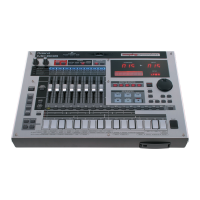21
An overview of the MC-808
Overview
Songs
fig.02-006.e
A song
consists of one or more patterns connected in the
desired playback order.
You can specify a playback order consisting of up to fifty
patterns.
Patterns and Parts
fig.02-007.e
A pattern
contains 1–998 measures of performance data that
plays the sounds (patches or rhythm sets) of up to sixteen parts.
The MC-808 provides 256 patterns.
Each part is analogous to a musician in a band or orchestra. The
MC-808 has sixteen parts, meaning that you can use sixteen
different patches or rhythm sets to play sixteen different
performances simultaneously.
Patches and Tones
fig.2-008.e
A patch
corresponds to a single instrument such as a piano or
guitar. Each patch consists of up to four tones. The MC-808
provides 896 different patches, giving you a wide variety of
sounds that you can enjoy simply by selecting and playing
them.
Tones are the building blocks of which a patch is made. The
MC-808 provides 622 waveforms, and two waveforms can be
assigned to a tone. (They can be assigned in stereo, with one for
the L side and one for the R side.)
Rhythm sets
fig.02-008.e
A rhythm set assigns a separate instrumental sound to each
note. (You can’t play scales or melodies using each instrumental
sound.) The MC-808 provides 128 rhythm sets.
Effect processors
The effect processors let you add a variety of effects to the
sounds of the patches or rhythm sets. You can use six different
effects simultaneously, using the six independent effect
processors: Compressor (which evens-out irregularities in the
level), Reverb (which adds reverberation), two Multi-effects
(each of which lets you choose one of 47 effect types such as
equalizer, overdrive, and delay), an External Input effect, and a
Master effect (which is applied to the final output of the MC-
808, making the overall volume more consistent).
Sampler
A sampler
is a device that captures wave files or external audio
sources such as a CD as “samples.”
The MC-808 lets you change the pitch of a sampled sound,
apply a filter to it, or modify its envelope, treating sampled
sounds in the same way as the waveforms provided by the
sound generator section.
The structure of the sounds
Pattern Pattern Pattern Pattern
Songs
Part 1
Part 2
Part 3
Part 16
patch (piano)
patch (guitar)
patch (rhythm set)
patch
measure measure measure
* Assign a patch to each part.
Pattern
Tone 1 Tone 2 Tone 3 Tone 4
Patch
KICK
SNARE
TOM CYMBALRIM
HI-HATCLAP
B3
MC-808_r_e.book 21 ページ 2007年7月17日 火曜日 午後5時1分

